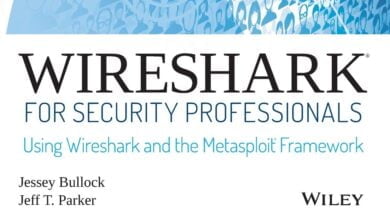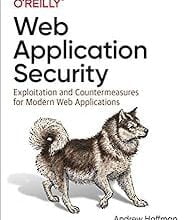A Bug Hunter's Diary: A Guided Tour Through the Wilds of Software Security
Exploring the Intricacies of Software Security with Tobias Klein

Hey, BugBusters! Are you ready to embark on a thrilling journey through the wilds of software security? Tobias Klein’s Diary: A Guided Tour Through the Wilds of Software Security is your ticket to an adventure filled with insights, challenges, and practical knowledge. This book is an engaging and essential guide for anyone interested in mastering software security, from curious novices to seasoned professionals.
Tobias Klein takes us on a captivating tour through the intricacies of software vulnerabilities, sharing personal anecdotes, technical insights, and real-world examples along the way. Millennials and tech-savvy individuals will find this guide particularly valuable and engaging because it blends relatable stories with deep technical content. Whether you’re just starting or looking to deepen your understanding, this book offers something for everyone in the dynamic landscape of cybersecurity.
About the Author
Tobias Klein is a renowned expert in software security with extensive experience in identifying and mitigating vulnerabilities. His professional background includes working with top-tier companies and institutions, where he honed his skills in security analysis and exploit development. Klein has a reputation for his meticulous approach to security and his ability to convey complex technical concepts in an accessible manner.
Among his notable achievements, Klein has discovered numerous critical security flaws in widely-used software, earning him respect and recognition within the cybersecurity community. His insights are precious because they come from years of hands-on experience and a deep understanding of the intricacies of software security.
In addition to his practical work, Tobias Klein has made significant contributions to cybersecurity education. He has authored several influential articles and papers, sharing his knowledge and expertise with the broader community. His ability to bridge the gap between technical detail and practical application makes his works essential reading for anyone serious about understanding and improving software security.
Overview of the Book
Diary: A Guided Tour Through the Wilds of Software Security by Tobias Klein is a masterful blend of technical instruction and engaging storytelling. The book is designed to provide readers with both practical guidance and personal insights into the world of software security.
Central Themes and Structure: The book is structured around a series of diary entries that Tobias Klein uses to narrate his experiences and discoveries in the field of software security. This unique format makes the content relatable and easy to follow, as readers can connect with Klein’s journey and learn from his firsthand experiences.
- Types of Vulnerabilities Covered: Klein delves into various common vulnerabilities that pose significant risks to software integrity. These include buffer overflows, format string vulnerabilities, and race conditions. Each type of vulnerability is explained in detail, with Klein providing clear examples and practical advice on identifying and mitigating these threats.
- Practical Applications of Techniques: The book doesn’t just focus on theory; it provides actionable techniques that readers can apply in real-world scenarios. Klein walks readers through step-by-step processes for exploiting and fixing vulnerabilities, ensuring they gain hands-on experience.
- Balancing Technical Detail with Personal Stories: One of the standout features of the book is how it balances deep technical detail with engaging personal stories. Klein shares anecdotes from his career, illustrating how he discovered and addressed various security issues. These stories make the technical content more engaging and provide valuable context that helps readers understand the importance and impact of security practices.
- Actionable Advice: Throughout the book, Klein offers practical advice that readers can implement immediately. From tips on setting up a secure development environment to strategies for conducting thorough security audits, the book is packed with insights that can enhance any security professional’s toolkit.
In summary, Diary: A Guided Tour Through the Wilds of Software Security is a comprehensive guide that combines technical skills with personal insights. Tobias Klein’s engaging writing style and extensive experience make this book an invaluable resource for anyone looking to deepen their understanding of software security. Whether you’re a novice or a seasoned professional, the blend of anecdotes and actionable advice will keep you informed and entertained while providing the tools you need to improve your security practices.
Key Highlights
Diary: A Guided Tour Through the Wilds of Software Security by Tobias Klein is packed with insightful chapters that significantly contribute to a deeper understanding of software security. Here are some of the key highlights:
Buffer Overflows: One of the book’s most important sections deals with buffer overflows, a common and dangerous vulnerability. Klein explains the concept in simple terms, provides detailed examples, and demonstrates how attackers exploit these flaws to gain unauthorized access. His real-world anecdotes about discovering and addressing buffer overflows add depth to the technical explanations, making this complex topic accessible and engaging.
Format String Vulnerabilities: Klein’s discussion on format string vulnerabilities is another highlight. He delves into the technical details of how these vulnerabilities occur and why they are dangerous. Readers learn how to detect and mitigate format string vulnerabilities through practical examples and clear explanations. Klein’s personal experiences and stories help illustrate the real-world impact of these vulnerabilities and the importance of addressing them promptly.
Race Conditions: The section on race conditions provides readers with a thorough understanding of this subtle yet critical vulnerability. Klein explains how race conditions can be exploited to disrupt the normal functioning of software, leading to potential security breaches. He shares practical strategies for identifying and preventing race conditions, supported by real-world examples that make abstract concepts concrete and relatable.
Real-World Examples and Practical Applications: Throughout the book, Klein emphasizes the practical applications of the techniques he discusses. He includes numerous real-world examples and case studies that show how to apply the knowledge gained in actual scenarios. These useful insights are particularly beneficial for readers looking to understand how to use their skills in real-world settings.
Unique Insights and Innovative Techniques: Klein’s extensive experience and innovative approach to software security provide readers with unique insights that set this book apart. He shares cutting-edge methods for identifying and mitigating vulnerabilities, offering advanced tips and techniques crucial for staying ahead in the ever-evolving field of cybersecurity.
Step-by-Step Guidance: One of the strengths of Klein’s writing is his ability to break down complex processes into manageable steps. Each chapter offers step-by-step guidance on exploiting and fixing vulnerabilities, ensuring readers can follow along and apply the techniques. This detailed, methodical approach helps demystify the intricacies of software security.
Focusing on these critical highlights, “Diary: A Guided Tour Through the Wilds of Software Security” provides a rich and comprehensive learning experience. The combination of foundational techniques, advanced methods, practical applications, and real-world examples makes this book an invaluable resource for anyone serious about mastering software security and enhancing their cybersecurity skills.
Why It’s Recommended for Cybersecurity Professionals
Diary: A Guided Tour Through the Wilds of Software Security by Tobias Klein is an invaluable resource for cybersecurity professionals at all levels. Here’s why this book stands out:
Utility for Novices: This book serves as an excellent introduction to software security for those new to cybersecurity. Klein’s clear explanations and step-by-step guidance make complex topics accessible. Novices will appreciate how the book builds a solid foundation by covering essential vulnerabilities like buffer overflows, format string vulnerabilities, and race conditions. The practical examples and real-world anecdotes help beginners grasp the concepts and understand their applications in real scenarios.
Advanced Insights for Experienced Professionals: Even seasoned cybersecurity experts will find valuable insights in Klein’s work. The book delves into advanced techniques and innovative strategies for identifying and mitigating software vulnerabilities. Experienced professionals can benefit from Klein’s detailed analysis and unique perspectives, which help deepen their understanding of software security. The advanced tips and cutting-edge methods shared in the book are essential for staying ahead in the rapidly evolving field of cybersecurity.
Practical Strategies for Discovering and Mitigating Vulnerabilities: One of the book’s greatest strengths is its focus on practical strategies. Klein provides actionable advice on discovering and mitigating vulnerabilities, ensuring readers can apply what they’ve learned directly. The hands-on exercises and step-by-step instructions make it easier for professionals to practice and refine their skills in a controlled environment. This practical approach is crucial for improving security practices and effectively addressing real-world threats.
Hands-On Knowledge and Tools: Klein’s book has hands-on knowledge and practical tools. Readers are guided through various security topics with detailed examples and exercises reinforcing their learning. The book introduces essential tools and techniques used in vulnerability assessment and mitigation, providing readers with the skills they need to perform effective security audits and enhance their overall security posture.
Ethical Considerations: Klein also addresses the moral implications of software security, highlighting the importance of conducting security research responsibly. He discusses legal boundaries and ethical responsibilities, ensuring readers understand the significance of ethical practices in cybersecurity. This focus on ethics is crucial for maintaining professional integrity and fostering trust within the cybersecurity community.
Improving Security Practices: By combining foundational knowledge with advanced techniques, Diary: A Guided Tour Through the Wilds of Software Security helps professionals improve their security practices comprehensively. Whether it’s learning to identify subtle vulnerabilities or mastering advanced mitigation strategies, the book equips readers with the tools and insights needed to protect software systems effectively.
In summary, Diary: A Guided Tour Through the Wilds of Software Security is a must-read for any cybersecurity professional looking to enhance their understanding of software security. Its blend of theoretical knowledge, practical strategies, hands-on exercises, and ethical considerations makes it an invaluable resource. Whether you are just starting or looking to deepen your expertise, this book provides the guidance and tools necessary to excel in the dynamic field of cybersecurity.
Engagement and Learning Path
Diary: A Guided Tour Through the Wilds of Software Security provides a strong foundation in software security, but continuous learning and practice are essential for mastering these skills. Here are some ways to further your education and apply the techniques from the book:
Join Online Communities: Engage with online forums and communities dedicated to cybersecurity and software security. Platforms such as Reddit’s r/netsec, Stack Overflow, and specialized forums like BugBustersUnited offer valuable opportunities to discuss concepts from the book, ask questions, and share experiences. These communities provide diverse perspectives and real-world insights that can deepen your understanding and keep you updated on the latest trends and techniques.
Participate in Workshops and Webinars: Look for workshops, webinars, and training sessions focused on software security. Events hosted by organizations like SANS Institute, Offensive Security, and local cybersecurity meetups offer hands-on labs and interactive sessions that complement the material covered in the book. Participating in these events allows you to practice techniques in a guided setting and learn from industry experts and peers.
Set Up Controlled Lab Environments: Practice the techniques outlined in the book by setting up your lab environment. Use platforms like Hack The Box, TryHackMe, or your virtual lab to create a controlled setting to experiment with security tools and strategies safely. This hands-on practice is crucial for internalizing the knowledge and developing the skills needed to become proficient in software security.
Engage in Continuous Learning: Cybersecurity is a rapidly evolving field with constant advancements and emerging threats. To stay current, continuously seek out new information and training opportunities. Read industry news, subscribe to cybersecurity blogs, and follow research papers to keep up-to-date. Books like Diary: A Guided Tour Through the Wilds of Software Security should be part of a broader learning journey that includes a variety of resources and learning methods.
Networking and Mentorship: Connect with other cybersecurity professionals through conferences, meetups, and professional organizations. Networking can lead to mentorship opportunities, collaborations, and knowledge sharing. Building relationships with experienced practitioners can provide guidance and support as you advance in your career.
By viewing Diary: A Guided Tour Through the Wilds of Software Security as an integral part of your ongoing education, you position yourself for growth and success in software security. Engage actively with the community, participate in learning events, and practice regularly to hone your skills and stay ahead in the ever-evolving cybersecurity landscape.
Conclusion and Call to Action
Diary: A Guided Tour Through the Wilds of Software Security by Tobias Klein is essential for anyone committed to mastering software security. The book provides a comprehensive look at vulnerabilities, practical strategies for mitigation, and real-world examples that enhance understanding and application.
Key takeaways from the book include:
- A solid foundation in identifying and mitigating common vulnerabilities such as buffer overflows, format string vulnerabilities, and race conditions.
- Practical, hands-on guidance through detailed examples and exercises.
- Insights into ethical considerations and the importance of responsible security practices.
- Unique personal anecdotes that make complex technical concepts relatable and engaging.
We encourage the BugBustersUnited community to share their thoughts and experiences with “Diary: A Guided Tour Through the Wilds of Software Security.” How has it influenced your approach to cybersecurity? What insights and techniques have you found most valuable? Your feedback helps create a more prosperous learning environment for everyone.
Continuous learning and staying updated with the latest cybersecurity strategies are crucial in this rapidly evolving field. By engaging with resources like this book and participating in community discussions, you can keep your skills sharp and stay ahead of emerging threats.
Join the conversation and tell us how Diary: A Guided Tour Through the Wilds of Software Security has impacted your cybersecurity journey. Together, we can build a knowledgeable, supportive community that excels in software security. Let’s work together to deepen our understanding and apply advanced techniques to protect our systems more effectively.




